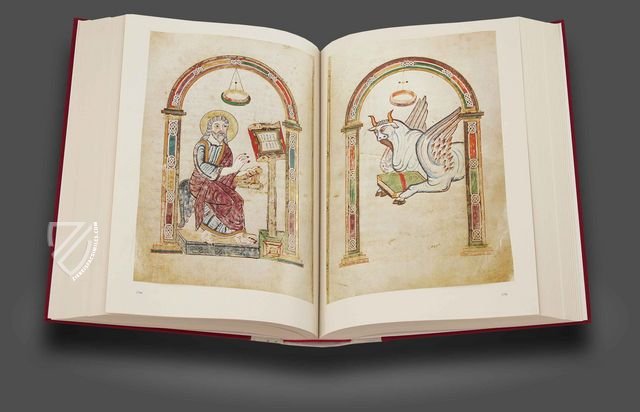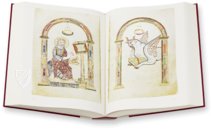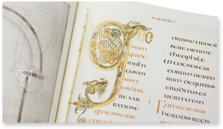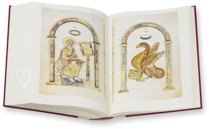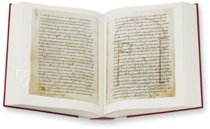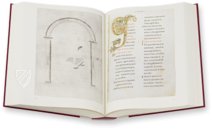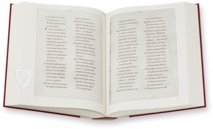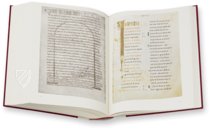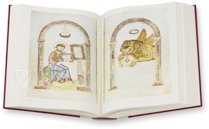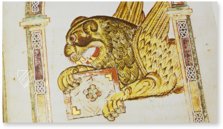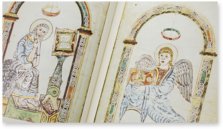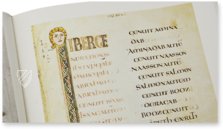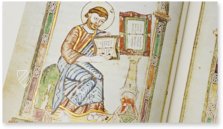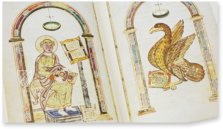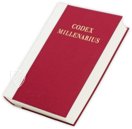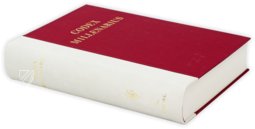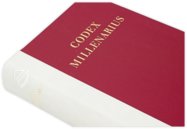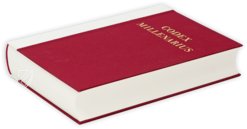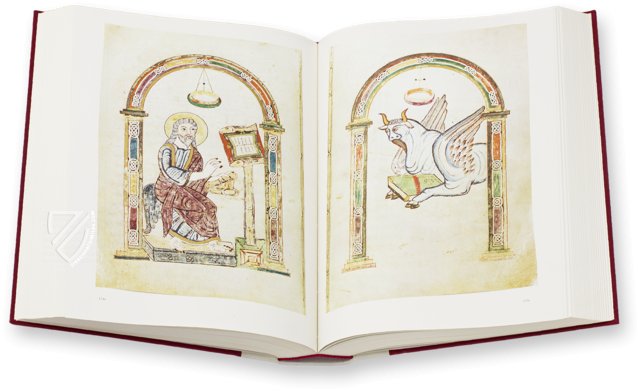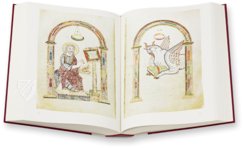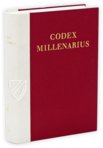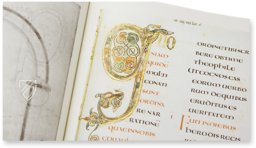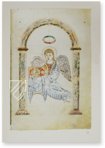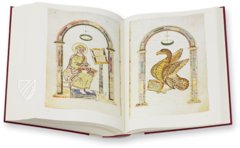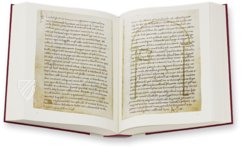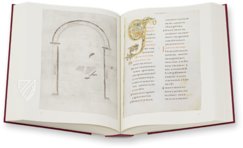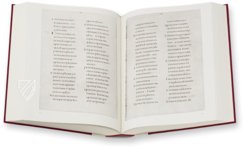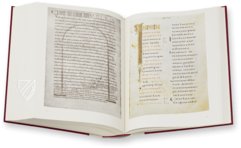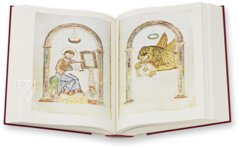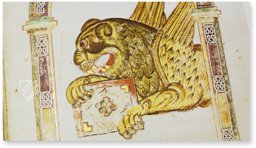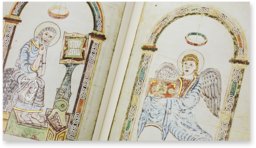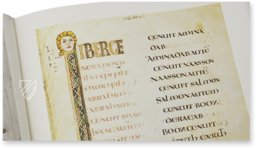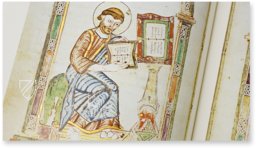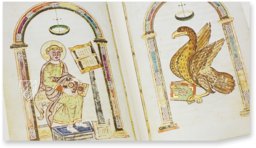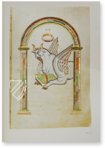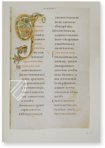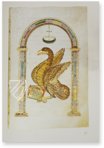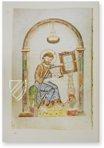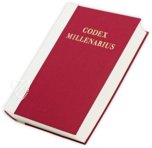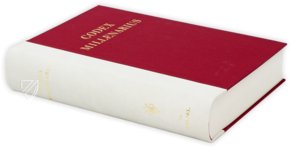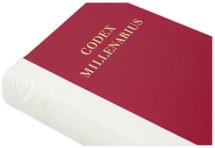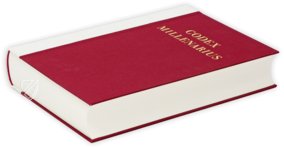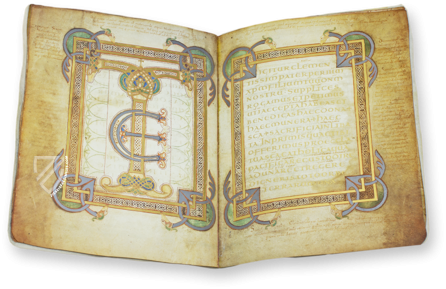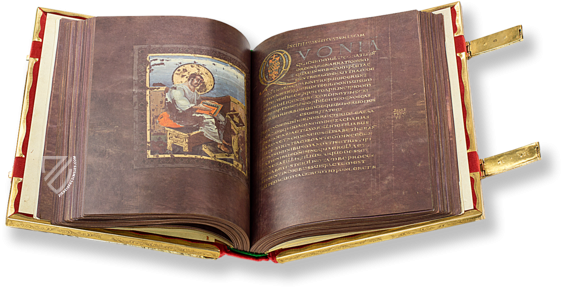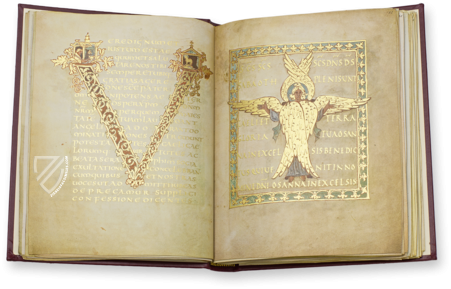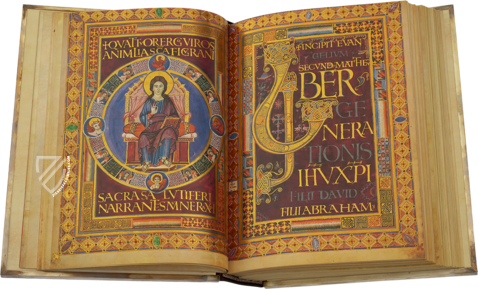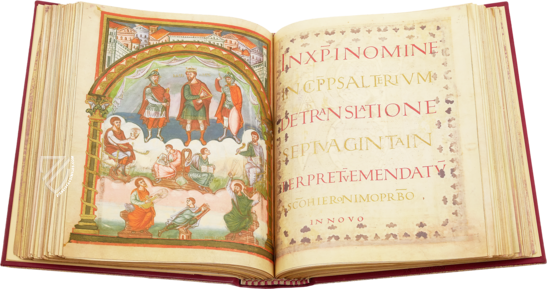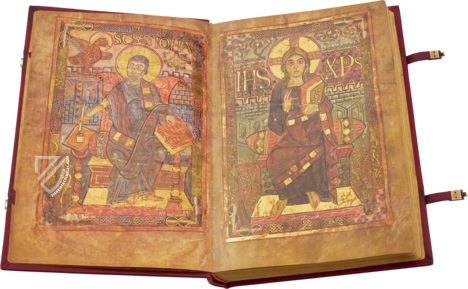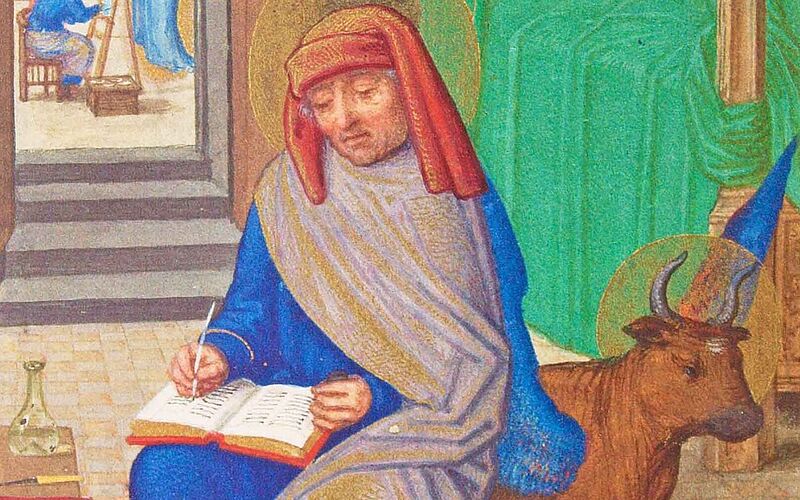Codex Millenarius
(1,000€ - 3,000€)
The Codex Millenarius is a plenarium, i.e. it contains all four Gospels in their entirety, but what is more, it introduces the Gospels with full page miniatures of the Evangelists and their symbols, and is the oldest such manuscript to employ this artistic device. This sumptuous 8th century manuscript has been in continual use at Kremsmünster Abbey for more than a millennium, hence its name. In addition, the text is the only well-preserved testimony to a now lost Bavarian-Austrian form of Vulgate. Therefore, this manuscript represents an artifact of tremendous value for researchers in art history, biblical history, cultural history, and linguistics.
Codex Millenarius
The Codex Millenarius contains all four Gospels in Latin translation and belongs to the three precious holy shrines of Kremsmünster Abbey, which are of outstanding spiritual value and of special cultural and historical interest. Together with Tassilo’s chalice and chandeliers, the Codex Millenarius has been used in liturgy up to this day. Its pricelessness is based on its age, the beauty of its script, and its excellent decoration. In addition, the text is the only well-preserved testimony to a now lost Bavarian-Austrian form of Vulgate. The Codex Millenarius was made ca. 800 either in the scriptorium of Mondsee, the mother monastery of Kremsmünster, or perhaps in Kremsmünster itself. It has remained at Kremsmünster ever since. The illumination goes back to the Carolingian period and comprises a total of eight full-page miniatures depicting the four Evangelists and their symbols, the four relevant sumptuous initials introducing the Gospel texts and a few remainders of the canon tables. The pictorial decoration is further ornamented with a solemn Carolingian script (uncial) which makes the holy text a truly unique holistic work of art.
A Millenary Jewel
The Codex Millenarius owes its name to the millenium anniversary celebrated by the venerable Abbey of Kremsmünster in 1777. When Garampi, the Papal nuncio in Vienna and former prefect of the Vatican Archives, saw the gospel book, he exclaimed: Vere hicce millenarius codex est(”This is truly a millenary book”).
Masterful Illumination and Calligraphy
We know of only a few other comparable manuscripts which pair the evangelists and their symbols on an equal footing in large full-page miniatures of the same size. The Millenarius is the oldest surviving manuscript in which these double images have been preserved to this day. Another unique feature of the Millenarius is the consistent insertion of all eight pictures into big arcades with round arches. These are framed alternately in gold and silver and decorated with interlacing ornament. The depictions of the evangelists and their symbols impress the reader by means of their dynamism and detailed appearance. The open books in the pictures of the evangelists, which show an extremely fine minuscule script, are of particular value in this context. Furthermore, the unique value of the Millenarius is visible in the beauty of its uniform script. A solemn, very standardized uncial from the Carolingian epoch highlights the sacred text. Each single leaf thus constitutes a graphical masterpiece, and was probably executed by a single artist.
A Unique Textual Testimony
The Codex Millenarius is a plenarium, i.e. it contains all four Gospels in their entirety: Matthew, Marc, Luke and John. The text is Vulgate though an important portion is Vetus Latina, which makes one assume that a predecessor was corrected from Vetus Latina into Vulgate. Only three manuscripts of this type have been handed down to us, of which the Codex Millenarius constitutes the best preserved example. The textual form of this Bavarian-Austrian type used in the Church province of Salzburg before Alcuin came along, is rooted in Northern Italy.
Codicology
- Alternative Titles
- Codex Millenarius maior
- Size / Format
- 700 pages / 34.0 × 23.0 cm
- Origin
- Austria
- Date
- Ca. 800
- Epochs
- Style
- Genre
- Language
- Script
- Uncial Rustic capitals Minuscule script
- Illustrations
- 8 full-page miniatures, 4 large decorative initials
- Content
- The Four Gospels in their entirety
Codex Millenarius
Matthew the Evangelist as an Angel
Holding his gospel with a serene expression on his face, Matthew the Evangelist is depicted as an angel dressed in a flowing blue cloak. Gold leaf has been used to highlight the corner fittings on the codex as well as his clothing, some of which has flaked off over the course of 1,200 years. The feathers of Matthew’s wings have been painted with great detail and his face is remarkably expressive thanks to the large eyes, broad nose, and full lips painted by the artist.
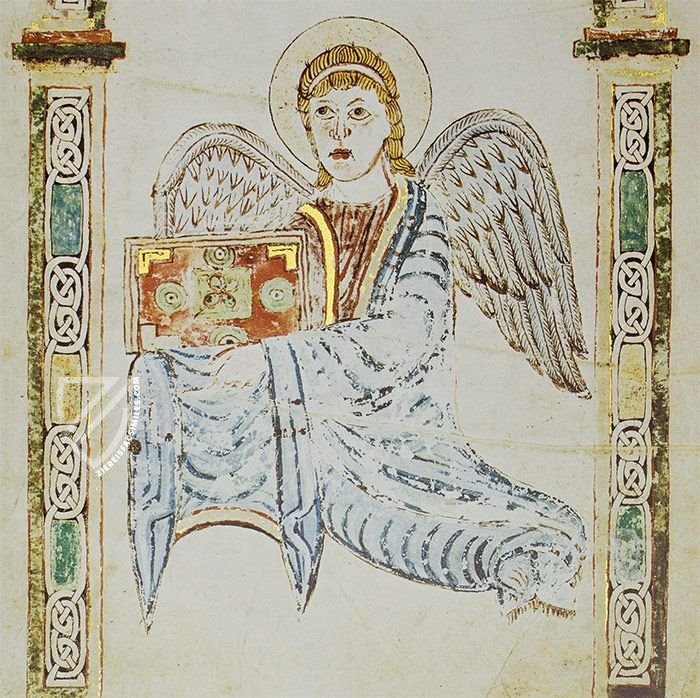
Codex Millenarius
Saint Luke as a Winged Bull
As the oldest surviving manuscript to contain full-page miniatures of the Evangelists and their symbols, this is one of the earliest depictions of Saint Luke and his symbol – a bull or ox, typically depicted with wings, as it is here. The fact that this symbol was given its own separate page points to the Insular tradition of illumination in which it is was created.
Although designed in the Insular style and including elements typical of Anglo-Irish art, such as the use of interlace, the classical influence in the miniatures, and the manuscript as a whole, is self-evident. Aside from being placed within a rounded Roman arch, the aesthetic style of the bull and color palette chosen by the artists are strongly influenced by Late Roman art.
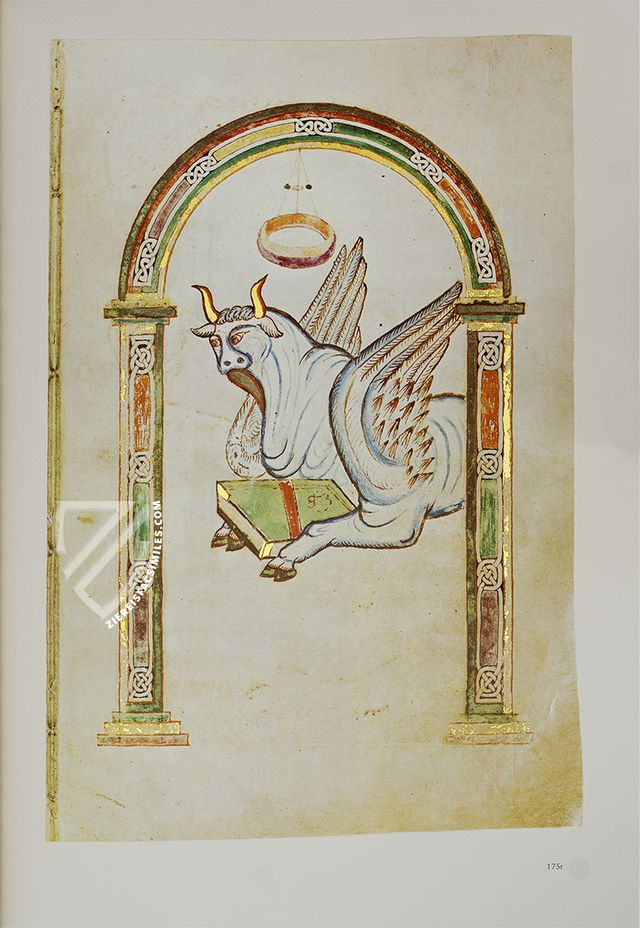
#1 Codex Millenarius
Language: German
The facsimile comes in a binding with a scholarly commentary in which Willibrord Neumüller, librarian of Kremsmünster Abbey, describes the textual form of the manuscript and its codicological analysis, and Kurt Holter explains the decoration from an art historian’s point of view.
W. Neumüller O.S.B., Kremsmünster, and K. Holter, Wels. 40 pp. text, 6 plates with 17 ill. and 1 colour plate.
(1,000€ - 3,000€)
- Treatises / Secular Books
- Apocalypses / Beatus
- Astronomy / Astrology
- Bestiaries
- Bibles / Gospels
- Chronicles / History / Law
- Geography / Maps
- Saints' Lives
- Islam / Oriental
- Judaism / Hebrew
- Single Leaf Collections
- Leonardo da Vinci
- Literature / Poetry
- Liturgical Manuscripts
- Medicine / Botany / Alchemy
- Music
- Mythology / Prophecies
- Psalters
- Other Religious Books
- Games / Hunting
- Private Devotion Books
- Other Genres
- Afghanistan
- Armenia
- Austria
- Belgium
- Belize
- Bosnia and Herzegovina
- China
- Colombia
- Costa Rica
- Croatia
- Cyprus
- Czech Republic
- Denmark
- Egypt
- El Salvador
- Ethiopia
- France
- Germany
- Greece
- Guatemala
- Honduras
- Hungary
- India
- Iran
- Iraq
- Israel
- Italy
- Japan
- Jordan
- Kazakhstan
- Kyrgyzstan
- Lebanon
- Liechtenstein
- Luxembourg
- Mexico
- Morocco
- Netherlands
- Palestine
- Panama
- Peru
- Poland
- Portugal
- Romania
- Russia
- Serbia
- Spain
- Sri Lanka
- Sweden
- Switzerland
- Syria
- Tajikistan
- Turkey
- Turkmenistan
- Ukraine
- United Kingdom
- United States
- Uzbekistan
- Vatican City
- A. Oosthoek, van Holkema & Warendorf
- Aboca Museum
- Ajuntament de Valencia
- Akademie Verlag
- Akademische Druck- u. Verlagsanstalt (ADEVA)
- Aldo Ausilio Editore - Bottega d’Erasmo
- Alecto Historical Editions
- Alkuin Verlag
- Almqvist & Wiksell
- Amilcare Pizzi
- Andreas & Andreas Verlagsbuchhandlung
- Archa 90
- Archiv Verlag
- Archivi Edizioni
- Arnold Verlag
- ARS
- Ars Magna
- ArtCodex
- AyN Ediciones
- Azimuth Editions
- Badenia Verlag
- Bärenreiter-Verlag
- Belser Verlag
- Belser Verlag / WK Wertkontor
- Benziger Verlag
- Bernardinum Wydawnictwo
- BiblioGemma
- Biblioteca Apostolica Vaticana (Vaticanstadt, Vaticanstadt)
- Bibliotheca Palatina Faksimile Verlag
- Bibliotheca Rara
- Boydell & Brewer
- Bramante Edizioni
- Bredius Genootschap
- Brepols Publishers
- British Library
- C. Weckesser
- Caixa Catalunya
- Canesi
- CAPSA, Ars Scriptoria
- Caratzas Brothers, Publishers
- Carus Verlag
- Casamassima Libri
- Centrum Cartographie Verlag GmbH
- Chavane Verlag
- Christian Brandstätter Verlag
- Circulo Cientifico
- Club Bibliófilo Versol
- Club du Livre
- CM Editores
- Collegium Graphicum
- Collezione Apocrifa Da Vinci
- Comissão Nacional para as Comemorações dos Descobrimentos Portugueses
- Coron Verlag
- Corvina
- CTHS
- D. S. Brewer
- Damon
- De Agostini/UTET
- De Nederlandsche Boekhandel
- De Schutter
- Deuschle & Stemmle
- Deutscher Verlag für Kunstwissenschaft
- DIAMM
- Droz
- E. Schreiber Graphische Kunstanstalten
- Ediciones Boreal
- Ediciones Grial
- Ediclube
- Edições Inapa
- Edilan
- Editalia
- Edition Deuschle
- Edition Georg Popp
- Edition Leipzig
- Edition Libri Illustri
- Editiones Reales Sitios S. L.
- Éditions de l'Oiseau Lyre
- Editions Medicina Rara
- Editorial Casariego
- Editorial Mintzoa
- Editrice Antenore
- Editrice Velar
- Edizioni Edison
- Egeria, S.L.
- Eikon Editores
- Electa
- Emery Walker Limited
- Enciclopèdia Catalana
- Eos-Verlag
- Ephesus Publishing
- Ernst Battenberg
- Eugrammia Press
- Extraordinary Editions
- Fackelverlag
- Facsimila Art & Edition
- Facsimile Editions Ltd.
- Facsimilia Art & Edition Ebert KG
- Faksimile Verlag
- Feuermann Verlag
- Folger Shakespeare Library
- Franco Cosimo Panini Editore
- Friedrich Wittig Verlag
- Fundación Hullera Vasco-Leonesa
- G. Braziller
- Gabriele Mazzotta Editore
- Gebr. Mann Verlag
- Gesellschaft für graphische Industrie
- Getty Research Institute
- Giovanni Domenico de Rossi
- Giunti Editore
- Graffiti
- Grafica European Center of Fine Arts
- Guido Pressler
- Guillermo Blazquez
- Gustav Kiepenheuer
- H. N. Abrams
- Harrassowitz
- Harvard University Press
- Helikon
- Hendrickson Publishers
- Henning Oppermann
- Herder Verlag
- Hes & De Graaf Publishers
- Hoepli
- Holbein-Verlag
- Houghton Library
- Hugo Schmidt Verlag
- Idion Verlag
- Il Bulino, edizioni d'arte
- ILte
- Imago
- Insel Verlag
- Insel-Verlag Anton Kippenberger
- Instituto de Estudios Altoaragoneses
- Instituto Nacional de Antropología e Historia
- Introligatornia Budnik Jerzy
- Istituto dell'Enciclopedia Italiana - Treccani
- Istituto Ellenico di Studi Bizantini e Postbizantini
- Istituto Geografico De Agostini
- Istituto Poligrafico e Zecca dello Stato
- Italarte Art Establishments
- Jan Thorbecke Verlag
- Johnson Reprint Corporation
- Josef Stocker
- Josef Stocker-Schmid
- Jugoslavija
- Karl W. Hiersemann
- Kasper Straube
- Kaydeda Ediciones
- Kindler Verlag / Coron Verlag
- Kodansha International Ltd.
- Konrad Kölbl Verlag
- Kurt Wolff Verlag
- La Liberia dello Stato
- La Linea Editrice
- La Meta Editore
- Lambert Schneider
- Landeskreditbank Baden-Württemberg
- Leo S. Olschki
- Les Incunables
- Liber Artis
- Library of Congress
- Libreria Musicale Italiana
- Lichtdruck
- Lito Immagine Editore
- Lumen Artis
- Lund Humphries
- M. Moleiro Editor
- Maison des Sciences de l'homme et de la société de Poitiers
- Manuscriptum
- Martinus Nijhoff
- Maruzen-Yushodo Co. Ltd.
- MASA
- Massada Publishers
- McGraw-Hill
- Metropolitan Museum of Art
- Militos
- Millennium Liber
- Müller & Schindler
- Nahar - Stavit
- Nahar and Steimatzky
- National Library of Wales
- Neri Pozza
- Nova Charta
- Oceanum Verlag
- Odeon
- Orbis Mediaevalis
- Orbis Pictus
- Österreichische Staatsdruckerei
- Oxford University Press
- Pageant Books
- Parzellers Buchverlag
- Patrimonio Ediciones
- Pattloch Verlag
- PIAF
- Pieper Verlag
- Plon-Nourrit et cie
- Poligrafiche Bolis
- Presses Universitaires de Strasbourg
- Prestel Verlag
- Princeton University Press
- Prisma Verlag
- Priuli & Verlucca, editori
- Pro Sport Verlag
- Propyläen Verlag
- Pytheas Books
- Quaternio Verlag Luzern
- Reales Sitios
- Recht-Verlag
- Reichert Verlag
- Reichsdruckerei
- Reprint Verlag
- Riehn & Reusch
- Roberto Vattori Editore
- Rosenkilde and Bagger
- Roxburghe Club
- Salerno Editrice
- Saltellus Press
- Sandoz
- Sarajevo Svjetlost
- Schöck ArtPrint Kft.
- Schulsinger Brothers
- Scolar Press
- Scrinium
- Scripta Maneant
- Scriptorium
- Shazar
- Siloé, arte y bibliofilia
- SISMEL - Edizioni del Galluzzo
- Sociedad Mexicana de Antropología
- Société des Bibliophiles & Iconophiles de Belgique
- Soncin Publishing
- Sorli Ediciones
- Stainer and Bell
- Studer
- Styria Verlag
- Sumptibus Pragopress
- Szegedi Tudomànyegyetem
- Taberna Libraria
- Tarshish Books
- Taschen
- Tempus Libri
- Testimonio Compañía Editorial
- Thames and Hudson
- The Clear Vue Publishing Partnership Limited
- The Facsimile Codex
- The Folio Society
- The Marquess of Normanby
- The Richard III and Yorkist History Trust
- Tip.Le.Co
- TouchArt
- TREC Publishing House
- TRI Publishing Co.
- Trident Editore
- Tuliba Collection
- Typis Regiae Officinae Polygraphicae
- Union Verlag Berlin
- Universidad de Granada
- University of California Press
- University of Chicago Press
- Urs Graf
- Vallecchi
- Van Wijnen
- VCH, Acta Humaniora
- VDI Verlag
- VEB Deutscher Verlag für Musik
- Verlag Anton Pustet / Andreas Verlag
- Verlag Bibliophile Drucke Josef Stocker
- Verlag der Münchner Drucke
- Verlag für Regionalgeschichte
- Verlag Styria
- Vicent Garcia Editores
- W. Turnowski Ltd.
- W. Turnowsky
- Waanders Printers
- Wiener Mechitharisten-Congregation (Wien, Österreich)
- Wissenschaftliche Buchgesellschaft
- Wissenschaftliche Verlagsgesellschaft
- Wydawnictwo Dolnoslaskie
- Xuntanza Editorial
- Zakład Narodowy
- Zollikofer AG

